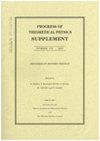弯曲时空中的动态对称性破缺
引用次数: 7
摘要
本文讨论了弯曲时空中四费米子相互作用的理论。从D维闵可夫斯基时空(2≤D≤4)出发,计算了1/ n阶展开的有效势,研究了该理论的相结构。用同样的方法计算了四费米子模型中复合算子ψψ在以下情况下的有效势:a) d维弱弯曲时空(线性曲率近似),b) d维德西特宇宙和反德西特宇宙,c) d维爱因斯坦宇宙。对该理论的相结构进行了分析和数值研究。讨论了费米子质量动态产生的曲率诱导相变。作为四费米子模型的扩展,我们考虑了弱弯曲时空中的量规Nambu-Jona-Lasinio (NJL)模型、高导数NJL模型和超对称NJL模型,并对其有效势进行了解析计算。再次分析了模型的相结构,并以解析形式给出了测量NJL模型发生手性对称性破缺的条件。最后分析了非零温度和引力场、非平凡拓扑和引力场以及磁场和引力场两种外部效应对四费米子模型相结构的影响。讨论了曲率和温度诱导相变或曲率和拓扑诱导相变的可能性。本文还认为,弱磁场破坏的手性对称性可能由于引力场的存在而得到恢复。简要探讨了四费米子模型在量子引力中的一些应用。论文发表在《科学进展》杂志上。定理。理论物理。增刊127 (1997)1 .电子邮件:inagaki@ipc.hiroshima-u.ac.jp 2 .电子邮件:muta@sci.hiroshima-u.ac.jp 3 .电子邮件:sergei@ecm.ub.es, odintsov@quantum.univalle.edu.co本文章由计算机程序翻译,如有差异,请以英文原文为准。
Dynamical Symmetry Breaking in Curved Spacetime
This review deals with the theory of four-fermion interactions in curved spacetime. Starting with the D-dimensional Minkowski spacetime (2 ≤ D ≤ 4) the effective potential in the leading order of 1/N-expansion is calculated and the phase structure of the theory is investigated. Using the same technique the effective potential for composite operator ψψ in four-fermion models is calculated under the following circumstances: a) D-dimensional weakly curved spacetime (in linear curvature approximation), b) D-dimensional de Sitter and anti-de Sitter universe, c) D-dimensional Einstein universe. The phase structure of the theory is investigated analytically as well as numerically. Curvature induced phase transitions are discussed where fermion masses are dynamically generated. As an extension of four-fermion models we consider the gauged Nambu-Jona-Lasinio (NJL) model, higher derivative NJL model and supersymmetric NJL model in weakly curved spacetime where the effective potential is analytically evaluated. The phase structure of the models is again analyzed and the condition for the chiral symmetry breaking in the gauged NJL model is given in an analytical form. Finally the influence of two external effects (non-zero temperature and gravitational field, nontrivial topology and gravitational field as well as magnetic and gravitational field) to the phase structure of four-fermion models is analyzed. The possibility of curvature and temperature-induced or curvatureand topology-induced phase transitions is discussed. It is also argued that the chiral symmetry broken by a weak magnetic field may be restored due to the presence of gravitational field. Some applications of four-fermion models in quantum gravity are also briefly investigated. This paper was published in Prog. Theor. Phys. Suppl. 127 (1997) 93. 1e-mail : inagaki@ipc.hiroshima-u.ac.jp 2e-mail:muta@sci.hiroshima-u.ac.jp 3e-mail:sergei@ecm.ub.es, odintsov@quantum.univalle.edu.co
求助全文
通过发布文献求助,成功后即可免费获取论文全文。
去求助

 求助内容:
求助内容: 应助结果提醒方式:
应助结果提醒方式:


